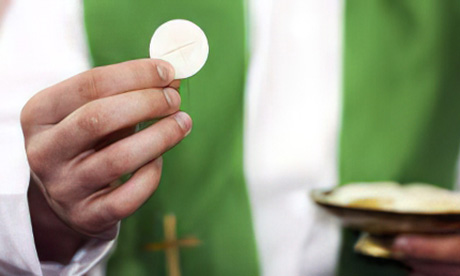“Only one-third of American Catholics believe that the Eucharist is the body and blood of Christ,” the US-based Pew Research Center noted last August.
“You see, even Catholics agree with us!” said the Protestants in a sigh of relief.
But conservative Catholics were greatly alarmed.
“Sixty-nine per cent of Americans who consider themselves Catholics do not believe Church teaching that the bread and wine actually become the body and blood of Christ during the consecration at Mass,” they said.
Both groups have missed the point.
A false dichotomy?
The Pew surveyed actually asked Catholics if they believed in “the Church’s teaching on transubstantiation” or that “bread and wine are symbols of the body and blood of Christ”.
In other words, it was a question of believing in transubstantiation or symbolism. But both terms are highly problematic when it comes to describing the Catholic faith in the Eucharist.
The Catholic Church, in fact, does not believe in “transubstantiation”. It is a term officially adopted in the thirteenth century to sensibly and intelligibly express the mystery of faith that Christ is truly present in the Eucharist under the species of bread and wine.
Catholics believe actually in the real presence. The concept of transubstantiation is merely a theological tool; the best we have.
Or, perhaps, the best we once had.
The term has become problematic. Indeed, the word “substance” sounds very different in our ears than it sounded in the ears of our ancestors. For us, the word includes such things as molecules, atoms and matter.
It’s all Greek to me
When the term “transubstantiation” entered Catholic teaching in the eleventh century, theologians such as Thomas Aquinas and others based their arguments on the philosophical thinking of the Greek philosopher Aristotle.
The latter used the term in a sense that means exactly the opposite of what we now understand it to mean.
The “substance” of an object, of something that exists, is for Aristotle everything except its matter and what is visible or tangible about it.
The Greek term he used (ousia), which was later translated into Latin as substantia, is probably best translated in our contemporary language as “being”.
Aristotle, in his attempt to understand reality, distinguished between the so-called “accidents” of an object and its “substance” (being).
The accidents concern everything that has to do with materiality and visibility: colour, form, material. For example, the “accidents” of a cupboard may be that it is made of wood, is brown and is 180 centimetres high. But the “substance” or the being of the cupboard does not depend on these accidents.
If, for example, we give the brown cupboard a beautiful blue colour with a brush or replace the wooden planks with glass plates, nothing changes in its “substance”, according to Aristotle. It remains “essentially” a cupboard. We could say that only a “trans-accidentation” has taken place.
When Christians come together around bread and wine and the priest presides over this Eucharist on behalf of Christ, all the “accidents” (the material and visible part of bread and wine) remain the same. But the very essence of the bread changes: trans-substantiation.
It is no longer bread to satisfy hunger and be able to eat together, but bread to satisfy spiritual hunger and gathered to truly participate with sisters and brothers in Christ’s offer of salvation.
There is no hocus pocus involved (even though this magician’s term comes from the Latin words hoc est corpus meum– “This is my Body”).
Transubstantiation can be felt only by people who know and believe inwardly that reality is not limited to its materiality. Indeed: that requires faith.
The problem with symbolism
The term “symbol” is equally problematic.
In general language, it is understood as a synonym for “not real”. But in the philosophical and Christian traditions, the term is used in a different way.
Namely, if we use “symbol” as referring to “things, places, events or persons that mediate a presence and an awareness of another reality,” it is a word that can also express something of the mystery of Christ’s real presence.
So do Catholics believe in transubstantiation, or do they see it as a symbol? It all depends on how you interpret, understand and use the terms “substance” and “symbol”.
Ultimately, of course, the mystery of faith cannot be adequately expressed in words.
The Eucharistic mystery of Christ’s real presence cannot be explained. It has to be celebrated and experienced ss a grace-filled mystery that, while ultimately transcending all understanding, truly makes one live.
That’s because in faith we know Christ presence, not beside or above reality, but in it and through it.
- Hendro Munsterman is a Roman Catholic theologian who teaches in France. He writes on faith and religion for the Dutch Christian daily Nederlands Dagblad where this article was originally published.
News category: Analysis and Comment.




